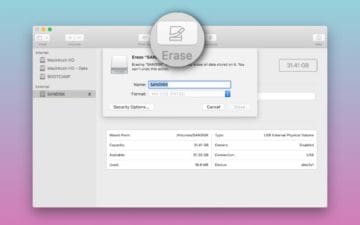

- Disk utility software for mac apple how to#
- Disk utility software for mac apple mac os#
- Disk utility software for mac apple password#
- Disk utility software for mac apple Pc#
The order of repair in this example was Macintosh HD - Data, then Macintosh HD, then Container disk4, then APPLE SSD. Keep moving up the list, running First Aid for each volume on the disk, then each container on the disk, then finally the disk itself.
Disk utility software for mac apple password#
If you're asked for a password to unlock the disk, enter your administrator password.Īfter Disk Utility is done checking the volume, select the next item above it in the sidebar, then run First Aid again. If the button is dimmed and you can't click it, skip this step for the disk, container, or volume you selected.  If there is no Run button, click the Repair Disk button instead. In this example, the last volume on the disk is Macintosh HD - Data.Ĭlick Run to begin checking the selected volume for errors. In the Disk Utility app on your Mac, choose File > RAID Assistant.
If there is no Run button, click the Repair Disk button instead. In this example, the last volume on the disk is Macintosh HD - Data.Ĭlick Run to begin checking the selected volume for errors. In the Disk Utility app on your Mac, choose File > RAID Assistant. 
You can also create a set that concatenates smaller disks to act as one larger disk. Click Cancel and it will turn off the Time Machine.Īfter you turn off the Time Machine, redo steps 4 to 6.For each disk that you're repairing, start by selecting the last volume on that disk, then click the First Aid button or tab. Create a disk set using Disk Utility on Mac You can create a Redundant Array of Independent Disks (RAID) set to optimize storage performance and increase reliability in case of a disk failure. that was bundled with all computers running the classic Mac OS. Time Machine in menu bar.” This will open another window. Disk First Aid is a free software utility made by Apple Inc. You can do this by opening System Preferences and unchecking the box This is an issue caused by Time Machine running on your external If your Mac includes an SSD, the Disk Utility software, Apple wont let you entirely wipe the hard drive. Click done toĬontinue,” don’t freak out about it. Other Macs models have Solid-State Drives (SSDs). If you get an error message that states, “Erase process has failed. This will immediately wipe the entire drive.
When you’re done with providing the setup details, click Erase. MS-DOS (FAT) is also compatible with Mac and PC, but you can only transfer files smaller than 4GB. Disk utility software for mac apple Pc#
exFAT is compatible with both PC and Mac. APFS (Apple File System) is only for newer Macs running macOS 10.13 or later. Disk utility software for mac apple mac os#
Mac OS Extended (Journaled) is the best option for most Mac users since it is compatible with all Macs. However, you can choose between the following formats: You can choose whatever name you want, and you should choose GUID Partition Map for the Scheme in most cases. Choose a name, format, and scheme for your drive. This will open a small pop-up window with a warning that erasing the drive will delete all data stored on it and that it can’t be undone. For the best result, select the disk (the highest option in the external tree). You can find this on the left-hand side of the screen under External Hard Drives. Click the external hard drive you want to format. Then click View in the top-left corner of the window and select Show All Devices. This will open the Disk Utility app, where you will find all the internal and external drives that are connected to your Mac. Go to Spotlight Search, type in Disk Utility, and click the first option. Some external hard drives need to be plugged into an outlet to work. /format-mac-drive-using-disk-utility-os-x-el-capitan-later-2260751-befc233e5020482f8dbbd2886cf59e0b.jpg) Connect an external hard drive to your Mac. Formatting your drive will wipe out all the data in it. Note : If you already used your external hard drive on a PC, be sure to back up any files on it.
Connect an external hard drive to your Mac. Formatting your drive will wipe out all the data in it. Note : If you already used your external hard drive on a PC, be sure to back up any files on it. Disk utility software for mac apple how to#
Here’s how to do that: How to Format a Hard Drive for Mac So if you’re trying to connect an external hard drive to a Mac, you might have to format the drive before you can use it. Most external hard drives are designed to work for Windows computers.





/format-mac-drive-using-disk-utility-os-x-el-capitan-later-2260751-befc233e5020482f8dbbd2886cf59e0b.jpg)


 0 kommentar(er)
0 kommentar(er)
